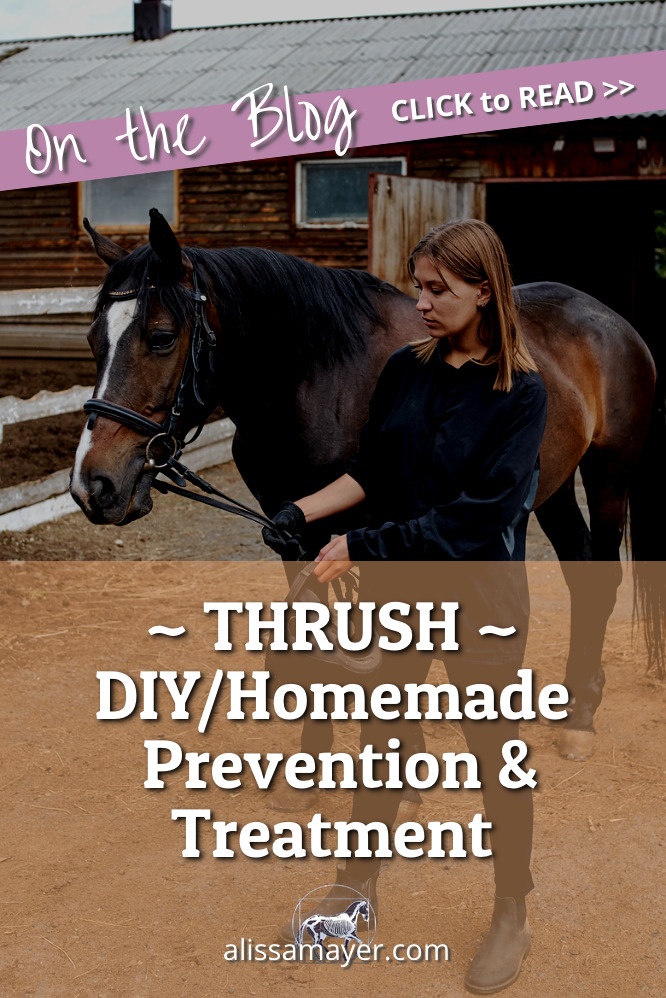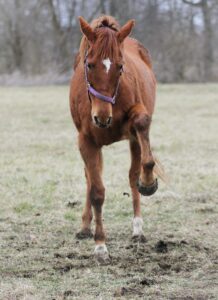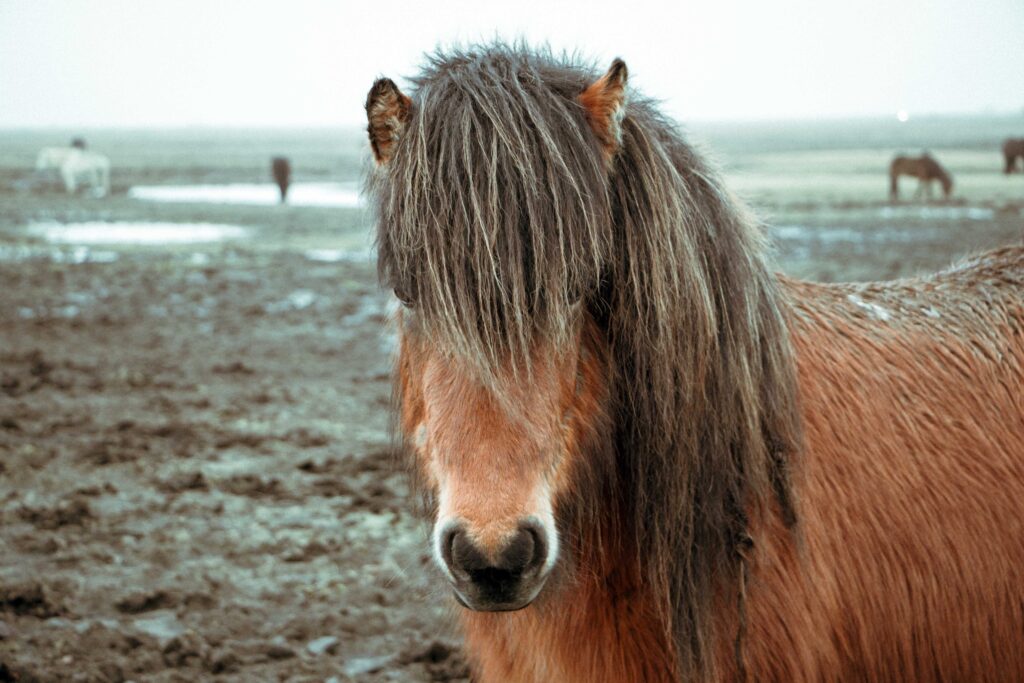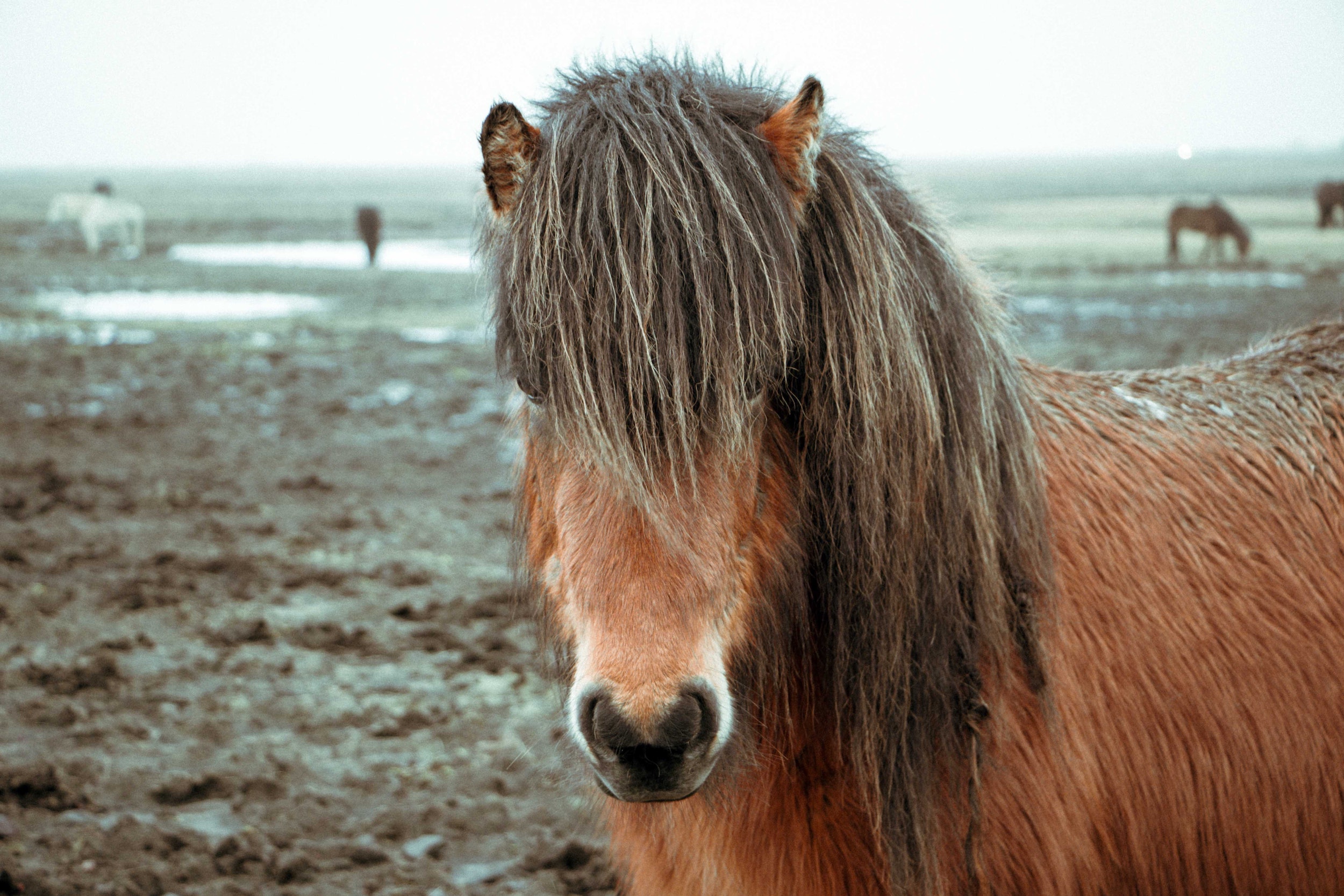It’s that time of year when the ground stays wet, the horses spend more time in the stables or shelters, and boot-sucking MUD appears in all the wrong places… Aside from the obvious mess and increased workload caused by winter weather, there is also a very real health impact on our horses hooves that is exacerbated by mud, muck and general dampness – THRUSH. So how do I prevent and remedy thrush in my horses hooves? With a homemade, all natural, non-toxic DIY thrush treatment for horses!
What is Thrush?

If you are the rare horse-person that has never experienced thrush, let me explain it to you.
It’s a sticky, stinky infection that creates black gunk that builds up in a horse’s foot underneath packed in mud and muck. It’s a combination of micro-organisms like bacteria, yeast and fungi that thrive in a wet, warm, anaerobic environment. These little organisms are everywhere in our environment, and generally cause no problems. But, when allowed to build up in a hoof they create a stinky thrush infection that can eat into the hoof tissue and cause damage, pain and lameness that can become severe if left untreated.
Thrush is an infection of the hoof is usually around the frog, but it can affect the sole and deeper tissues too. Moist or damp or dirty footing and bedding can make thrush more likely, but it can occur in dry environments as well – especially the deeper infections, which can be sneaky to diagnose and difficult to treat.
Don’t worry, I won’t let thrush get you down… keep reading to learn all about my homemade thrush treatment for horses, my Funky Hoof Spray recipe, and my top tips for prevention!
Typical Products used for Treating Hoof Thrush

There are tons of products on the market to treat thrush, I’m sure you’ve seen and used many of them! But they usually have pretty strong or even toxic ingredients, and if you know me, you already know that I don’t like to use anything on my animals that has warnings in fine print.
Kopertox and Thrush Buster* are two of the products I’ve seen most often used to treat thrush. Both can be effective in eradicating mild cases of thrush when used correctly – daily on a clean and dry hoof. However, they are both very strong, can dry out the hoof and will stain anything they touch, including your skin, clothing and horse hair.
*CAUTION: Recent research has revealed that products containing Gentian Violet (the purple stuff in Thrush Buster) may increase the risk of cancer, so I strongly recommend you read the ingredients on every product you have in your first aid or grooming kit and stop using anything with gentian violet!
Do NOT use: bleach, formaldehyde, or undiluted hydrogen peroxide on your horses hooves. They are too strong, and can kill damaged or healing tissue and cause pain and delayed healing. I also advise you to avoid using a strong anti-microbial product daily, as overuse can cause antibiotic resistant strains of microbes to evolve that will be resistant to future treatment!
3 Steps to Preventing a Thrush Infection
“No hoof, no horse!”
Prevention really is the best medicine! The first thing to do is make sure you are feeding your horse adequate and balanced minerals to optimize hoof health. There’s a whole LOT of info and research to do to learn what exactly your horse needs, but if you don’t want to become your own equine nutritionist, you can cheat and just do what I do:
My horses get free choice plain and Redmond salt (I use a combo of salt block and loose salt) and free choice kelp meal. Both should be available at your regular feed store. I also feed a balanced mineral and probiotic supplement called California Trace Plus – it’s formulated by a hoof care professional named Sally Hugg. Sally went full-geek on learning about equine nutrition, so we don’t have to! Her product is formulated to balance out the deficiencies in so much of our soils in North America – not just in California. Aaaaand, if you can’t get it from your local feed store, you can order from her website and they’ll deliver it promptly!
The second cheap and easy part of prevention is simple, regular hoof care: Thrush is an anaerobic infection, so oxygen will kill it. Keeping the hoof clean is the best way to get oxygen to the hoof tissues, but not practical 24/7, I know. Daily picking and an occasional scrub with Dawn dish soap is doable, right?
Thirdly, after cleaning the hoof, use my Daily Funky Hoof Spray (recipe below). This homemade hoof spray is the key to my natural thrush treatment and prevention program for all my horses!

Treating a Mild Thrush Infection with my Homemade Remedy
For a hoof that’s just a little funky, scrub the foot with Dawn dish soap and rinse thoroughly. If possible let the hoof dry, and then apply my Funky Hoof Spray.
Here’s the Recipe for my Funky Hoof Spray:
- Fill a sturdy one-liter spray bottle with a 50/50 mix of plain water and cheap white vinegar.
- Add 20 drops of Lavender Essential Oil (calming and cleansing)
- Add 20 drops of Tea Tree Essential Oil (disinfecting and anti-microbial)
- Add 10 drops of Lemon Essential Oil (stimulates the immune system)
Shake the bottle before each use to make sure the oils are well distributed, and use daily.
These ingredients are safe and non-toxic for your horses and pets, your skin and your kids. Tea Tree oil can be irritating in it’s undiluted form, so use caution when mixing in your drops, and don’t add any more than the recipe calls for.
I like to buy my essential oils from an awesome Oregon company called Mountain Rose Herbs – because they are diligent about only sourcing organic, fair-trade and quality ingredients. AND, because they are not a multi-level marketing company, their prices are waaaaay better than the typical EO options!
Treating a Mild-Moderate Infection with my Homemade Thrush Treatment
For a hoof that is super stinky/gunky or sore from infection, you’ll need to deep-clean before going to just the daily spray application.
- Scrub the affected hoof with soap and water, and/or spray with a hose for several minutes to remove deeply embedded gunk.
- On the first day of treatment, soak the foot with a 50/50 mix of 3% hydrogen peroxide and water for 10 minutes (this is just for the initial deep clean – do not use this soak daily, as it may slow healing). If the mixture gets muddy it will lose it’s cleaning and disinfecting ability, so dump it and mix a fresh batch for the next foot – this is why you want to clean the hooves before soaking!
- Trim off any loose flaps of frog (but not too much!) or crumbling sole or hoof wall
- Allow hooves to dry thoroughly (tie the horse in a dry spot, for an hour or so after soaking or put in a stall with deep clean bedding. In a perfect world, you would keep the hooves clean and dry for several days to allow the thrush to clear up.
If it’s not realistic for you to keep your horse in a clean and dry environment (like a bedded stall that is cleaned several times per day) you can cover the hooves to keep them out of the muck. If you don’t have boots, get some Hoof-Wraps Bandage/Booties (affordable, tough enough for several days of turn-out, can be cut to fit any hoof and can be used over shoes if necessary). After you adjust the fit by cutting the pad to the right size, put them on your horse with a generous dusting (dumping, really) of Gold Bond Medicated Foot Powder inside. This can help keep the hoof clean-ish, but don’t use them in deep mud or you will just lose your wraps.
- pick out and spray the hooves daily (and clean and dry the boots, if you are using them)
- This is more than enough for most mild-moderate cases of thrush to begin healing.
Treating a Moderate-Tough Hoof Infection with my Homemade Thrush Treatment + a Soaking Program
For a moderate-tough case, start with the same initial cleaning and diluted peroxide soak I describe above.
- Then, soak with a 50/50 mix of cider vinegar and water for 20-40 minutes at a time, 1-2x/day for 3 days. (A soaking boot or bag makes this much easier than a bucket that the horse keeps kicking over…) The gnarlier the hoof funk or infection, the longer you should soak it. BUT if the hoof has any open wounds or bloody spots, vinegar will STING, so we have to start with something less acidic, like an epsom salt soak and a thorough drying-out before starting the vinegar soaks.
- Use my Funky Hoof Spray daily once any open wounds or raw areas on the hoof have dried out.
- If at all possible, keep the horse indoors for a few days to let the hooves really dry out and any open or damaged areas start to heal over. Avoid turning the horse out into muddy conditions, or boot them if you absolutely have to put them out, but line the boots with felt or put wool socks on under the boots to draw moisture away from the sole… and don’t forget your foot powder.
How long does it take to Remedy a Thrush infection?
Most superficial to moderate infections should be well on the way to clearing up after about 3 days of this treatment protocol, but you should continue for 6-7 days just to be safe. If the thrush infection isn’t improving, or if the horse is in pain or still lame after a week of treatment, please consult with your vet and have your horse checked for a deeper infection. It is still possible to help a horse beat a deep infection with a homemade thrush treatment, but it’s a little different – keep reading to learn how.
Also, chronic thrush infections can be a symptom of chronic laminitis! Click here to read my post on understanding and treating laminitis and founder.
Deep Thrush Infections in the Central Sulcus of the Frog
It’s possible for a hoof to develop a deep sulcus thrush infection that is not wet, stinky or easy to see from the outside. The hoof my appear clean and dry, yet harbor the infection deep in the center of the foot – which can be very painful and difficult to treat. Often the only indication is that the horse is lame or slightly off, has a toe-first landing, and/or that the heel of the hoof looks like a butt-crack between the heel bulbs.
If this sounds like your horse – sure, use my Daily Hoof Spray for prevention of surface thrush, but you need to address the deeper infection ASAP! Pete Ramey has a great article on how to recognize and treat a deep sulcus thrush infection here: https://www.hoofrehab.com/Thrush_treatment.htm
Adjust the Diet to Support a Healthy Hoof and Strong Immune System
In addition to using a homemade thrush treatment for horses, like my Funky Hoof Spray recipe and gentle soaking program, your horse will have the best chance at remaining thrush-free by having strong healthy hooves and an optimized immune system.
Here are some dietary considerations that will help your horse be his or her healthiest self:
- reduce sugar (in complete feeds, grains, beet pulp, treats, stressed grass)
- add hay if you need more calories (high fiber is the healthiest diet for a horse)
- add a hoof supplement with biotin, or feed 1 tsp plain gelatin daily
- remember to balance the minerals (too much is as bad as too little!)
- if you give free choice kelp/seaweed, make sure it hasn’t been treated with urea
Lastly, whether you are battling thrush or just want to be prepared, make sure your horse is getting regular hoof care & plenty of exercise. Exercise activates the hoof’s natural self-cleaning mechanisms and also stimulates circulation. Good circulation encourages a healthy immune and inflammatory response, and speeds up healing.
Always use a qualified farrier or barefoot trimmer for regular trimming and hoof balancing – or learn to do it yourself. Don’t go over-long between trims, as overgrowth of the hoof and frog can harbor hiding places for the organisms that cause thrush. Also, the more material there is to trim off each time, the more stress there is on the tendons and ligaments.
If you’d like to learn more about the risks of gentian violet, check out this article: https://horsesport.com/horse-news/veterinary-products-gentian-violet-cancer-risk/
Good luck! If you have found other natural and non-toxic remedies that work for treating or preventing thrush in your horse – let us know in the comments below!


